Henry James thought that George Eliot was rather obtuse about the visual arts. When he reviewed Cross's Life of Eliot, James commented particularly upon her responses to painting and sculpture: "She enumerates diligently all the pictures and statues she sees, and the way she does so is proof of her active, earnest intellectual habits; but it is rarely apparent that they have, as the phrase is, said much to her, or that what they have said is one of their deeper secrets'' (James, p. 499). Another American, Charles Eliot Norton, judged Eliot's aesthetic sensibility even more harshly after visiting the Priory in 1869: "Indeed all the works of art in the house bore witness to the want of delicate artistic feeling, or good culture on the part of the occupants, with the single exception, so far as I observed, of the common lithograph of Titian's 'Christ of the Tribute Money"' (Letters, V, 8). Both James and Norton underestimated George Eliot's sensitivity to painting, but their remarks do point to some limitations which should be acknowledged at the outset of any attempt to characterize her taste in the visual arts.
Certainly George Eliot did not have a Jamesian sensitivity to plastic values. Her comments on pictures usually seem a bit wooden when one comes to them from James's. Among the sister arts she responded more deeply to music than to painting or sculpture. "I agree with you as to the inherent superiority of music," she wrote to an early correspondent; ". . . painting and sculpture are but an idealizing of our actual existence. Music arches over this existence with another and a diviner" (Letters, I, 247). Her taste for pictures was more self-consciously acquired, and less natively sophisticated than her taste for music.2 It was also relatively conventional. When she writes of history, sociology, philosophy, or fiction, George Eliot seems progressive if not avant-garde; but when she writes of painting and sculpture, she seems more orthodox, a follower rather than a leader of trends.
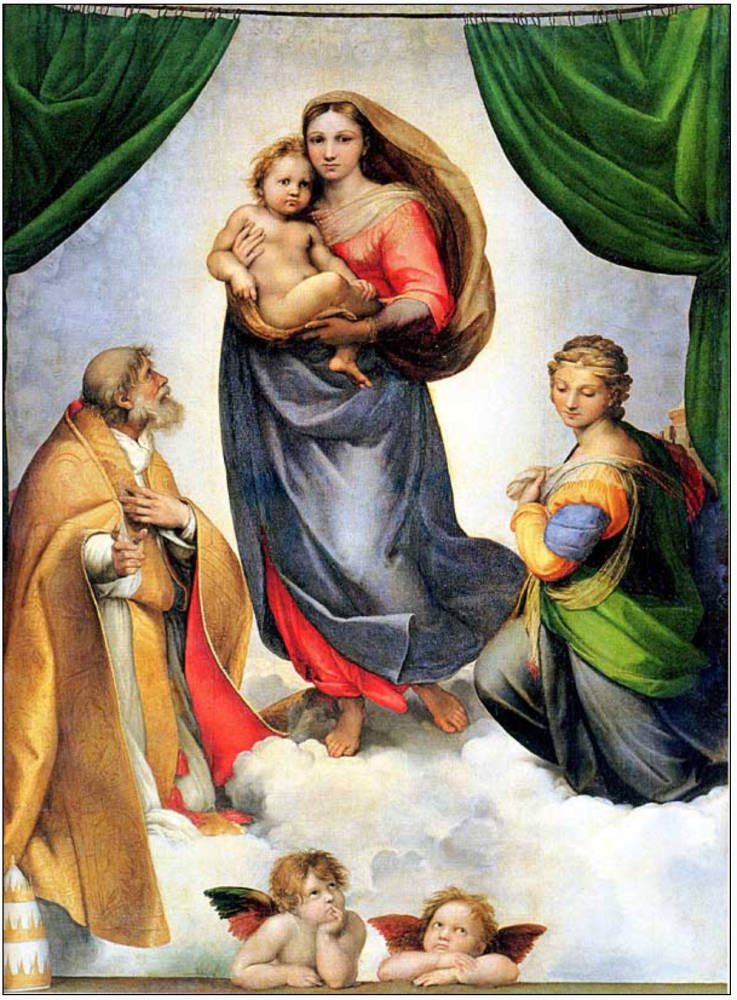
Left: Raphael, Sistine Madonna. Gemäldgalerie Alte Meister, Dresden. Figure 1 in print version.
To admit these limitations, however, is not to say that she is superficial, as James would have it, or vulgar, as Norton suggests. In a sensibility such as George Eliot's, even conventional responses are profound and distinctive. A case in point is her reaction to Raphael's Sistine Madonna, her favorite painting in all the world. To this picture she responded as the eighteenth-century traveler did to the sublime in landscape: with awe and fear, with a sense of being overwhelmed by something greater than the mind can comprehend. "I sat down on the sofa opposite the picture for an instant," she wrote in her Dresden journal, "but a sort of awe, as if I were suddenly in the living presence of some glorious being, made my heart swell too much for me to remain comfortably, and we hurried out of the room" (Cross, II, 47). Two days later, G. H. Lewes had a similar experience; he says that he "looked at the Raphael Madonna di San Sisto, till I felt quite hysterical."3 No superlative in George Eliot's vocabulary could do justice to Raphael's painting; it was "this sublimest picture," "the Einzige Madonna," "the matchless Madonna di San Sisto."4 In the face of such ecstasy, James's charge of superficiality cannot stand. George Eliot could perceive the "deeper secrets" of pictures and could respond to them with the strongest emotions. This chapter, will explore several dimensions of her passion for pictures: her affection for certain genres, styles, and schools; her criteria of critical judgment; and her iconic use of pictures in personal meditation.
The most common misconception about George Eliot's taste is that it was limited entirely to the genre painting of the seventeenth-century Dutch masters and their nineteenth-century descendants in the sentimental line of Greuze, Spitzweg, and Wilkie. The source of this notion is the famous passage in chapter 17 of Adam Bede in which the narrator praises a "rare, precious quality of truthfulness . . . in many Dutch paintings" (17:268). From this passage and several like it in Scenes of Clerical Life, Mario Praz derived his misleading but influential thesis about George Eliot's Biedermeier taste. But the narrator of Adam Bede does not programmatically exclude the other genres, and George Eliot certainly liked and used them as well. Her first love was really European portraiture, of all periods and schools. More purely than other genres, portraiture posed a problem that occupied her as a novelist: how best to represent human beings. After portraiture, she admired the sacred and heroic painting of the Italian Renaissance and of Rubens. Here she found a union of the ideal with the real that she longed to recapture in her own art. Furthermore, she loved landscape painting with a passion that combined the picturesque, the Wordsworthian, and the naturalistic modes of response. These four kinds — portraiture, history painting, genre, and landscape — figure in her fiction in roughly that order of importance.
In pictorial styles, George Eliot's tastes were distinct but not exclusive. The High Renaissance style was her favorite, but she could also appreciate the mannerist and baroque styles [I use the terms "High Renaissance" and "baroque" in the sense given them by Heinrich Wolfflin in Principles of Art History, trans. M. D. Hottinger (New York: Henry Holt, 1932)]. Her early reactions to Rubens are interesting in this connection. He was the first great painter whose work, seen in the original and in quantity, entirely captivated her. She was taken by the scale and energy of his history paintings, and by the vividness of his portraits; but she felt rather guilty about her response. From Munich in 1858 she wrote:
Rubens gives me more pleasure than any other painter, whether that is right or wrong. To be sure, I have not seen so many pictures and pictures of so high a rank, by any other great master. I feel sure that when I have seen as much of Raffaelle, I shall like him better, but at present Rubens more than any one else makes me feel that painting is a great art and that he was a great artist. His are such real, breathing men and women — men and women moved by passions, not mincing and grimacing and posing in mere apery of passion! What a grand, glowing, forceful thing life looks in his pictures — the men such grand bearded grappling beings fit to do the work of the world, the women such real mothers (Letters, II, 450-51. For other references to Rubens, see Letters, IV, 270 and Cross, I, 269-70; II, 20-21, 43, 49, 189.)
These remarks show George Eliot attracted by two different styles. On the one hand, she was culturally predisposed toward Raphael and a Raphaelite norm of beauty — classical, spiritualized, and serene. On the other hand, she could also take pleasure in the style of Rubens — baroque, fleshly, and dynamic. The preference for a Renaissance style was the dominant strain in her taste, determining her great affection for Leonardo da Vinci, Bernardino Luini, and Andrea del Sarto. (See Cross, II, 33, 187-90, 206-07; Letters, VII, 288; "Italy 1864," entries for May 9-11 and June 5-10.) The inclination toward the mannerist and baroque styles was a secondary strain in her taste, governing her strong but qualified admiration of Michelangelo and Tintoretto, whose work often struck her as powerful and magnificent, but sometimes seemed merely "ugly." When combined, these two aspects of her taste resulted in Eliot's curious admiration of statuesque and monumental female figures, of which we shall see several striking examples in chapter 6.
As the preceding observations suggest, Eliot's view of the historical schools and masters was fairly conventional. For her, the Italian Renaissance was the greatest period; Florence, Milan, and Venice were the greatest schools; and Raphael and Titian were the greatest masters of all time. For the "early Italians," from Giotto to Perugino, she harbored a warm affection; but she resisted the Romantic tendency to rank them, for purity of spirit, above the later Renaissance masters. Following Ruskin, she admitted to an "utter dislike of the Bolognese school" (Cross, II, 196); and she detested Guido Reni (Cross, II, 49, 88), whom she burlesqued in Middlemarch as "the celebrated Guydo, the greatest painter in the world" (60:115). Among the northern European schools, she most admired the Dutch, the German, and the Flemish. She cared less for seventeenth-century Dutch landscape than one might expect; but she was an ardent student of the genre painters, and knew the work of Vermeer, the Van Ostades, Dou, Metsu, Mieris, Terborch, Maes, Ryckaert, Teniers the Younger, and Steen (Cross, II, 49; Haight, pp. 259, 264). She loved Rembrandt for the truthfulness of his portraiture, but she did not care for his history paintings and did not rank him among the supreme masters.9 Her favorite German painters were Holbein and Dürer, whose vivid realism fascinated her. Her passion for Rubens, though early, was abiding.
Among the later schools, George Eliot's preferences were fewer [23/24] but no less strong. She was devoted to the English portrait tradition that extends from Van Dyck to Lawrence. Under the tutelage of Modern Painters, she also loved the nineteenth-century English school of landscape painting. And she was certainly receptive to the sentimental genre painting of her Victorian contemporaries. Her views of the English Pre-Raphaelites and their German precursors, the Nazarenes, were mixed; but she followed the work of both brotherhoods with the utmost interest. The Dusseldorf school of modern German history painting attracted her, and the monumental art of Munich and Berlin interested her; but she strongly disliked German neoclassicism in the Winckelmann tradition. To French neoclassicism and French Romanticism she paid very little attention; the French painters she knew best were those promoted in England by Gambart: Paul Delaroche, Ary Scheffer, and Rosa Bonheur.

The Transfiguration by Raphael (Raffaello Sanzio, 1483-1520). 1516-1520
When George Eliot looked at a picture from one of her favorite schools, what did she see? Her letters and her entries in journals suggest that she judged painting by a Ruskinian combination of moral and aesthetic criteria. These include greatness of subject, truthfulness of representation, adequacy of expression, and handling of formal elements such as color and perspective. Though indivisible in practice, these standards may be separated for discussion.
Greatness of subject or conception is a criterion of neoclassical aesthetics which persists in the thought of both Ruskin and George Eliot, who emphasized "the choice of noble subjects" in her review of Ruskin's third volume ("Art and Belles Lettres," 627). It rests upon a Neoplatonic hierarchy of ideas, graduated according to their inherent nobility and running from the sacred to the profane, from the aristocratic to the vulgar, from the heroic to the domestic. Treatment being equal, the painting or poem which embodies the greater subject is to be valued more highly. As Ruskin puts it in Modern Painters, volume III,
the habitual choice of sacred subjects, such as the Nativity, Transfiguration, Crucifixion (if the choice be sincere), implies that the painter has a natural disposition to dwell on the highest thoughts of which humanity is capable; it constitutes him so far forth a painter of the highest order. [Works 5.49]
Their empiricism notwithstanding, the Leweses shared Ruskin's belief. As G. H. Lewes declared in 1858:In Art, as in Life, there is high and low, great and little; and everything that is represented is interesting in proportion to its truth of presentation and its objective value; a well-painted tablecover is better than an ill-painted face; but a well-painted face with a noble expression, is the highest reach of art, as the human soul is the highest thing we know.
The terms "high" and "low" here reflect a value judgment that Lewes cannot, in the end, explain on empirical or psychological grounds. George Eliot also applied the criterion of "objective value" to art, often to rule out certain subjects as unfit to be represented "for no one," she declared, "can maintain that all fact is a fit subject for art" (Essays, p. 146). Thus she objected to Browning's The Ring and the Book because "the subject is too void of fine elements to bear the elaborate treatment he has given to it" (Letters, IV, 501) Even the famous defense of Dutch painting in Adam Bede does not obliterate the distinction between high and low subjects. The narrator simply argues that there is value in the faithful representation of vulgar subjects:
Paint us an angel, if you can, with a floating violet robe, and a face paled by the celestial light; paint us yet oftener a Madonna, turning her mild face upward and opening her arms to welcome the divine glory; but do not impose on us any aesthetic rules which shall banish from the region of Art those old women scraping carrots with their work-worn hands, those heavy clowns taking holiday in a dingy pot-house, those rounded backs and stupid weather-beaten faces that have bent over the spade and done the rough work of the world — those homes with their tin pans, their brown pitchers, their rough curs, and their clusters of onions. In this world there are so many of these common coarse people. [17:270]
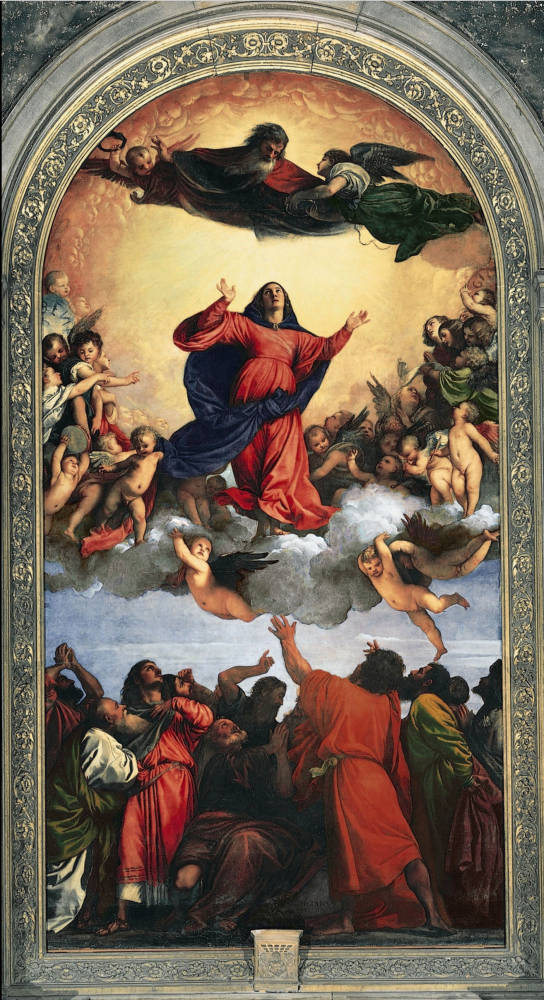
Left: Titian, The Assumption of the Virgin. Figure 2 in print version.
The Madonna described in this passage is Titian's The Assumption of the Virgin. The angel is probably one of Fra Angelico's.
It is not quite accurate to say, as Martin Price does, that George Eliot here "effects a transference of sublimity to the low and ugly.' (p. 102). She is pleading for catholicity of taste and sympathy, but not for a leveling of artistic subject matter. Eliot's narrator has [25/26] strong prejudices about the limitations of the Dutch school, as does Ruskin, whose qualified defense of Dutch art in Modern Painters underlies chapter 17 of Adam Bede.
Like Ruskin, however, George Eliot preferred a low subject truthfully represented to a high subject falsely represented. By truthfulness of representation she did not mean simple mimesis or photographic realism, although she could delight as much as the next spectator in trompe-d'oeil effects (Cross, 1, 277). Rather, she meant verisimilitude of a more psychological sort — the fidelity of the artist to his vision of the world. "We can say a 'truthful representation' and a 'truthful exposition,"' George Eliot maintained, "but I think the strict meaning in that case is always, that the artist or expositor has no impulse to suppress or exaggerate or falsely colour the fact as apprehended by his knowing faculties" (Letters, III, 144). On another occasion she declared: "I only try to exhibit some things as they have been or are, seen through such a medium as my own nature gives me" (Letters, II, 362). Truthfulness in this sense is mature vision sincerely rendered; its antithesis is ignorant conceit masking as reality. Darrell Mansell, Jr. describes this marriage of mimetic and expressive principles quite accurately: "George Eliot wants to produce Ruskin's very special kind of 'realism'; she wants to study the real world humbly and faithfully, and then to present the real world as it has mirrored itself in her imaginative mind."
We may see the criterion of truthfulness at work in George Eliot's first confrontation with the overwhelming art of Rome. At first she found herself "thrown into a state of humiliating passivity by the sight of the great things done in the far past — it seems . . . as if my own activity were so completely dwarfed by comparison that I should never have courage for more creation of my own." But the outlook was not entirely daunting. "There is only one thing that has an opposite and stimulating effect: it is, the comparative rarity even here of great and truthful art, and the abundance of wretched imitation and falsity. Every hand is wanted in the world that can do a little genuine, sincere work" (Letters, III, 294). By false and imitative art, George Eliot meant art predicated upon a sentimental preconception, rather than a careful observation, of its subject. The "abundance of wretched imitation and falsity" in the Roman school caused Eliot to rank it well below the schools of Florence, Milan, and Venice. In Middlemarch, Dorothea too is struck by the rarity of great and truthful art in Rome, though she finds the vacuum merely depressing rather than stimulating.
To no element in a picture did George Eliot apply the criterion of truthfulness more carefully than to expression. She agreed with G. H. Lewes that "a well-painted face, with a noble expression, is the highest reach of art, as the human soul is the highest thing we know" ("Realism in Art," p. 499).To her nineteenth-century eye, expression was the gateway to the soul, the mind, the passions, the sentiments, transmitting the invisible life through a visible language of facial and corporal signs. According to Ruskin, "the expression of the thoughts of the persons represented will always be the first thing considered by the painter who worthily enters that highest school [of art]" (Modern Painters III, in Works 5.51). Expression was certainly the first thing considered by George Eliot in most pictures of human figures. It was her point of imaginative entry into such paintings; if it failed, so, usually, did her sympathy for the vaulting as a whole. But if expression succeeded, it could redeem many flaws, as we may see in her account of Titian's The Assumption of the Virgin:
For a thoroughly rapt expression I never saw anything equal to the Virgin in this picture; and the expression is the more remarkable because it is not assisted by the usual devices to express spiritual ecstasy, such as delicacy of feature and temperament or pale meagreness. Then what cherubs and angelic heads bathed in light! The lower part of the picture has no interest; the attitudes are theatrical; and the Almighty above is as unbeseeming as painted Almighties usually are: but the middle group falls short only of the Sistine Madonna. [Cross, II, 205]
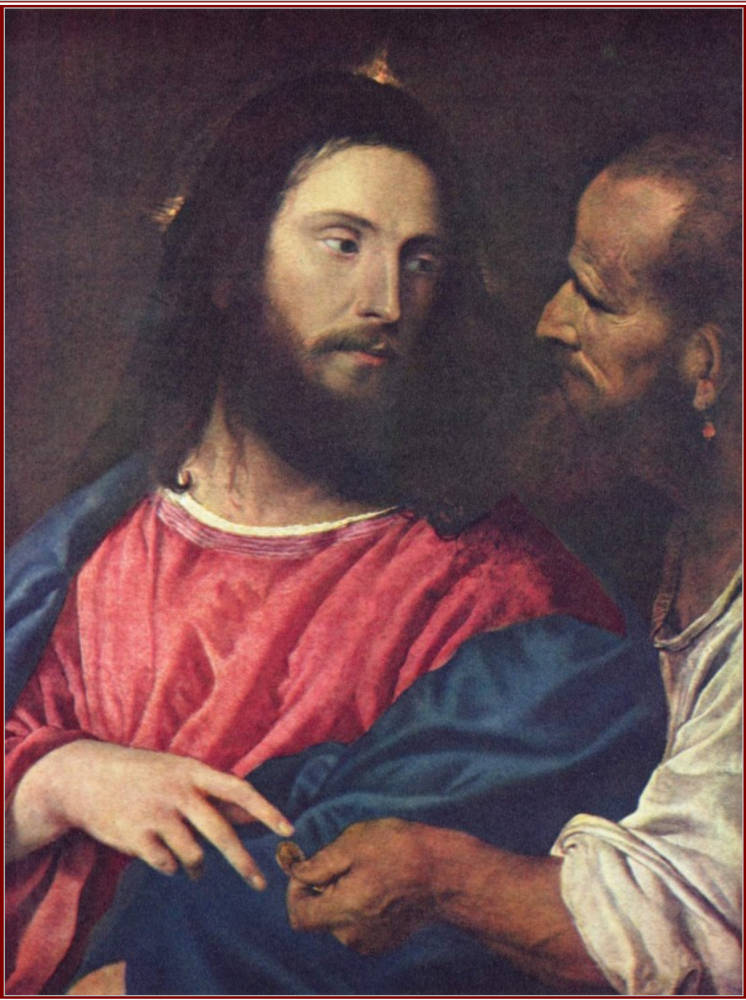
The Tribute Money. Figure 22 in print version.
Titian's Assumption is alluded to by the narrator of Adam Bede (17:270), and an engraving of it hangs in the Meyricks' parlour in Daniel Deronda: "the Virgin soaring amid her cherubic escort" (20: 312). The Assumption is one of three works by Titian that ranked second only to the Sistine Madonna in George Eliot's esteem; and the other two — St Peter Martyr and The Tribute Money — she valued also for their expression. Conversely, nothing infuriated her more in a painting than false — that is to say, mannered, affected, or theatrical — expression. Thus she attacked Guido Reni's work at Dresden: "Guido is superlatively odious in his Christs, in agonized or ecstatic attitudes — much about the level of the accomplished London beggar" (Cross, II, 49).
Her interest in phrenology was another manifestation of her concern for expression. Although she renounced her early faith in phrenology as a science, she never entirely abandoned physiognomical premises in her descriptions of people, paintings, and fictional characters. Because they relate physical appearance to character, phrenology and expression give painting a border with the literary arts, whose special province is the representation of the inner life.
When she shifted her attention from representational to more purely aesthetic considerations, and analyzed the formal elements of a painting, George Eliot used an uncomplicated vocabulary. She mainly noticed "form," meaning composition; "color," which included lighting; "perspective"; and "finish." She was not as sensitive as Henry James was to some of these formal properties, but she was certainly not indifferent to them either. Fully to satisfy her, a painting had to excel in several respects. Rubens's Deposition in the Antwerp Cathedral, for example, received high marks in nearly all of the principal categories: "colour, form, and expression alike impressed me with the sense of grandeur and beauty" (Cross, I, 270). Similarly, at Munich she liked "a very striking 'Adoration of the Magi,' by Johannes van Eyck, with much merit in the colouring, perspective, and figures" (Cross, II, 27). As a rule she preferred finished pictures, which eliminate the traces of brushwork and labor, to unfinished ones, which proclaim their materials and making.
These preferences and standards of judgment were part of George Eliot's conscious culture, matters of study and carefully worded declaration. But Eliot also perceived pictures in a way that was less judicious and more intimate than any discussed so far. She liked to hold pictures in her memory, and to contemplate them as reminders of absent persons or places whom she loved intensely. In other words she used pictures as icons in personal meditation, to focus and sustain her affections. "But I remember you very vividly," she wrote to one friend, "and if I were a painter I could make a sketch of you still, either under the bowering trees of your garden, or on your drawing room sofa with the vase of flowers before you" (Letters, III, 449). In Romola the heroine commissions a posthumous portrait of her father "lest his image should grow dim in her mind"; the icon is to assist her in performing "the duties of memory" (28:389), thus fulfilling Jean Hagstrum's notion of "sacramental pictorialism" in The Sister Arts, pp. 128-29.
This art of memory has its origins in the Christian tradition of meditation, and is a secular analogue of that religious practice. In Christian meditation, the devotee recreates and relives a scriptural or exemplary scene in his imagination, the better to grasp an underlying doctrinal truth. Icons, effigies, skulls, and the like may be used to assist the spiritual exercise; but the ultimate aim is a vivid inward seeing in which the will and the emotions are strengthened and directed toward right values. As Louis L. Martz has shown, meditative disciplines were widely practiced by Catholics and Protestants alike from the seventeenth century onward (pp. 153-75). George Eliot's grasp of the tradition appears in her account of Dinah Morris's preaching, which relies upon the rhetorical equivalent of meditative picturing:
"See!" she exclaimed, turning to the left, with her eyes fixed on t a point above the heads of the people — "see where our blessed I Lord stands and weeps, and stretches out his arms towards you. . . . See the print of the nails on his dear hands and feet. Ah! how worn and pale he looks! [2:40]
Savonarola's preaching in Romola employs the same rhetorical technique (12:191). Daniel Deronda explains the rationale of meditation to Gwendolen as follows:
Fixed meditation may do a great deal towards defining our longing or dread. We are not always in a state of strong emotion, and when we are calm we can use our memories and gradually change the bias of our fear, as we do our tastes.... Try to take hold of your sensibility, and use it as if it were a faculty, like vision." [36:268]
George Eliot grew up in this Christian tradition, and retained its habits long after she rejected Christian theology. Paradoxically, religious meditation solaced her for her loss of religious faith. According to Clara Bray, when Marian Evans was translating Strauss's The Life of Jesus, Critically Examined, "she said she was Strauss sick — it made her ill dissecting the beautiful story of the crucifixion, and only the sight of her Christ-image and picture made her endure it" (Letters, I, 206). Gordon S. Haight reports that the "Christimage" was a small cast of Thorwaldsen's figure of the resurrected Jesus, and the "picture" was the popular Blanchard engraving (1844) of Paul Delaroche's Savior or The Head of Christ. 22 In other words, even as she was crucifying Jesus anew, "dissecting" and burying him for the last time, George Eliot found emotional solace in contemplating images of his resurrection and triumph. Her habits of meditation survived her renunciation of Christian theology, and continued in a secularized form to nourish her emotional life.
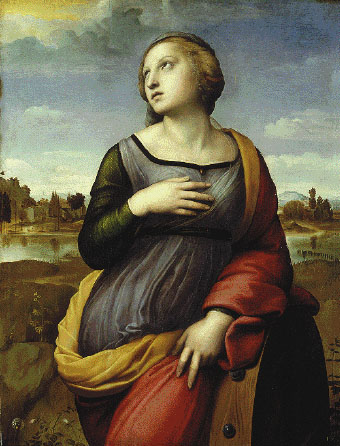
Saint Catherine of Alexandria by Raphael (Raffaello Sanzio, 1483-1520),
Secularized meditation substitutes friends for saints and experienced scenes for legendary ones in its affectionate imagining (See Wiesenfarth, p. 30). Traces of this transference from saints to friends sometimes linger in the similes Eliot uses to describe her remembrances: "As it is, you are a bright picture in my memory, like Raphael's St. Catherine," she wrote to an absent friend in 1845, "and I assure you I give you a high place among influences when I range you with pictures" (Letters, I, 188). If the original purpose of meditation was to bestow a phenomenal reality upon sacred subjects, George Eliot's meditations reverse that process and bestow a sacredness upon phenomenal experience. To Barbara Bodichon she vowed: "I will call you only Barbara, the name I must always associate with a true, large heart. Some mean, treacherous Barbara may come across me, but she will only be like a shadow of a vulgar woman flitting across my fresco of St. Barbara" (Letters, III, 119). This habit of imagining friends in terms of pictured saints exactly parallels, and perhaps gave rise to, George Eliot's fictional device of describing her heroines as saints and madonnas.
As for setting, the elaborate "composition of place" prescribed by most manuals of meditation yields in humanistic spiritual exercises to memories of actual places. For example, George Eliot composed a place when she wrote from London to her friends in Coventry: "I hope my imagination paints truly when it shows me all of you seated with beaming faces round the tea-table at Rosehill" (Letters, I, 292). So graphic was her memory of people and places that Eliot sometimes rejected the aid of actual pictures as more likely to blur than to sharpen her mental image. "My inward representation even of comparatively indifferent faces is so vivid," she wrote, "as to make portraits of them unsatisfactory to me" (Letters, VII, 233).
She applied her remarkable powers of visual memory to works of art as well as to people. Cross recalled her "limitless persistency in application . . . whilst looking at pictures" (Cross, III, 371). When she fell in love with a picture, a statue, or a building, she studied it with the aim of registering its details in her mind's eye, so that after leaving it she might still contemplate and cherish it, as she contemplated and cherished images of absent or dead friends. On her trip to Italy in 1860, for example, she reproached herself for inattention in this regard:
I am not enjoying the actual vision enough, and . . . when higher enjoyment comes with reproduction of the scene in my imagination I shall have lost some of the details, which impress me too feebly in the present because the faculties are not wrought up into energetic action. ["Recollections of Italy 1860," Yale]24
A similar exhortation to retain "the actual vision" animates her description of the Niobe group in Berlin: "How grieved I shall be if the image of that mother in anguish sheltering her youngest child from the inevitable dart, becomes vague in my imagination" ("Recollections of Berlin," Yale). George Eliot's memory for objects d'art seems to have needed more prodding than her memory for living faces; but assisted by the mnemonic entries in her journals, by prints, and by her meditative habits of imagination, she carried a rich musée imaginaire behind her gray eyes.
A few precious paintings suited George Eliot's taste perfectly. They satisfied all of her moral and aesthetic criteria and also became icons in her personal meditations. The Sistine Madonna and several works by Titian belonged to this small group of favorite master pieces, as we have seen. So did Rubens's Crucifixion, of which George Eliot saw the Antwerp version in 1854 and the Munich version in 1858. Her description of the Munich version illustrates much that we have said about her taste in the visual arts:
Jesus alone, hanging dead on the Cross, darkness over the whole earth. One can desire nothing in this picture: the grand, sweet calm of the dead face, calm and satisfied amidst all the traces of anguish, the real livid flesh, the thorough mastery with which the whole form is rendered, and the isolation of the supreme sufferer, make a picture that haunts one like a remembrance of a friend's deathbed. [Cross, II, 21]
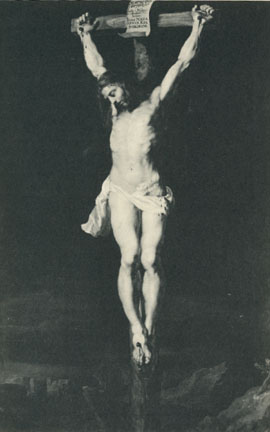
Peter Paul Rubens, The Crucifixion. Munich, Alte Pinakothek. Figure 3 in print version. Click upon image for larger picture, which takes longer to download.
Here all of George Eliot's standards function together harmoniously. Rubens's picture exemplifies greatness of conception ("the supreme sufferer"), truthfulness of execution ("the real livid flesh, the thorough mastery with which the whole form is rendered"), perfection of expression ("the grand, sweet calm of the dead face"), superb color and form ("darkness over the whole earth . . . the isolation of the supreme sufferer"), and finally an iconic stimulus to meditation ("a picture that haunts one like a remembrance of a friend's deathbed"). Her writings contain no better synopsis of what George Eliot liked in a picture.
The power of pictorial images thus to focus the viewer's attention and sympathies is a rationale for their use in fiction. The novelist can affect his readers deeply by summoning images to their minds through his descriptive language. His power so to "paint" with words is limited by the nature of his medium, as George Eliot clearly recognized; but literary pictorialism was nonetheless central to her theory of fiction.
Created 2000; reformatted 2007 and 14 April 2015
